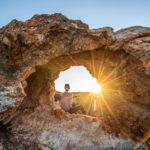 Australia and Indonesia have united to propel geotourism to new heights in a groundbreaking partnership, capitalizing on the global fascination with nature-based travel experiences. Geotourism, which celebrates the distinctive geographical features of a place while upholding sustainability, is predicted to become a booming sector, estimated to be worth around US$1.2 billion by 2033. This lucrative market potential has prompted the Australian Geoscience Council (AGC) and the Indonesian Geoparks Network (IGN) to sign a Memorandum of Understanding (MoU), solidifying their commitment to promoting their countries as world-leading destinations for nature enthusiasts.
Australia and Indonesia have united to propel geotourism to new heights in a groundbreaking partnership, capitalizing on the global fascination with nature-based travel experiences. Geotourism, which celebrates the distinctive geographical features of a place while upholding sustainability, is predicted to become a booming sector, estimated to be worth around US$1.2 billion by 2033. This lucrative market potential has prompted the Australian Geoscience Council (AGC) and the Indonesian Geoparks Network (IGN) to sign a Memorandum of Understanding (MoU), solidifying their commitment to promoting their countries as world-leading destinations for nature enthusiasts.
Dr Kevin Cassidy, Chair of the AGC, and Mohamad Farid Zaini, Chairman of the IGN, inked the historic MoU on May 25, signalling a united front in the pursuit of elevating the profile of geotourism in Australia and Indonesia. With a focus on sustainable tourism that highlights a place’s environment, heritage, aesthetics, culture, and the well-being of its residents, geotourism enriches traditional nature-based tourism by introducing innovative offerings such as geology, landscapes, flora and fauna, and cultural heritage. Both nations boast captivating geotourism sites, including the Murchison GeoRegion in Western Australia, the Ku-ring-gai, and the Glen Innes Highlands GeoRegions in New South Wales.
The IGN comprises 10 UNESCO Global Geoparks and nine national geoparks, which actively promote geotourism, agrotourism, marine tourism, sports tourism, and cultural tourism while serving as centres for education. Through this collaboration, the AGC aims to broaden the appreciation of geosciences among the Australian population and stimulate interest in related academic fields. Geosciences play a crucial role in understanding the Earth’s geology, and fostering its recognition can have far-reaching effects, such as encouraging more tertiary enrollments in geoscience and ensuring a future supply of highly qualified geoscience professionals and researchers.
Professor David Cohen, President of the Australian Geoscience Council, expressed the significance of the MoU, stating, “Australia is blessed with amazing geology – from some of the oldest rocks and earliest indicators of life on Earth to spectacular mineral deposits that formed as our continent evolved. With such diversity and rich geological history, geotourism is a natural extension of nature-based and cultural tourism because it encompasses a range of attractions.” The AGC and the IGN collaboration seeks to achieve several objectives, including developing geosites, mining heritage sites, geological time walks, rock gardens, geotrails, and geoparks. Moreover, the partnership aims to enhance the reputation of both Indonesia and Australia as premier nature-based tourism destinations, improve the quality of geoscience education, facilitate joint conferences on geopark and geotrail development, and foster sister relationships between geoparks and relevant organizations in the two countries.
With this groundbreaking collaboration, Australia and Indonesia are poised to harness the potential of geotourism and position themselves at the forefront of this burgeoning industry. As travellers increasingly seek unique and sustainable experiences that showcase the Earth’s natural wonders, the partnership between these two nations will undoubtedly leave an indelible mark on the geotourism landscape.
Written by: Anne Keam

















